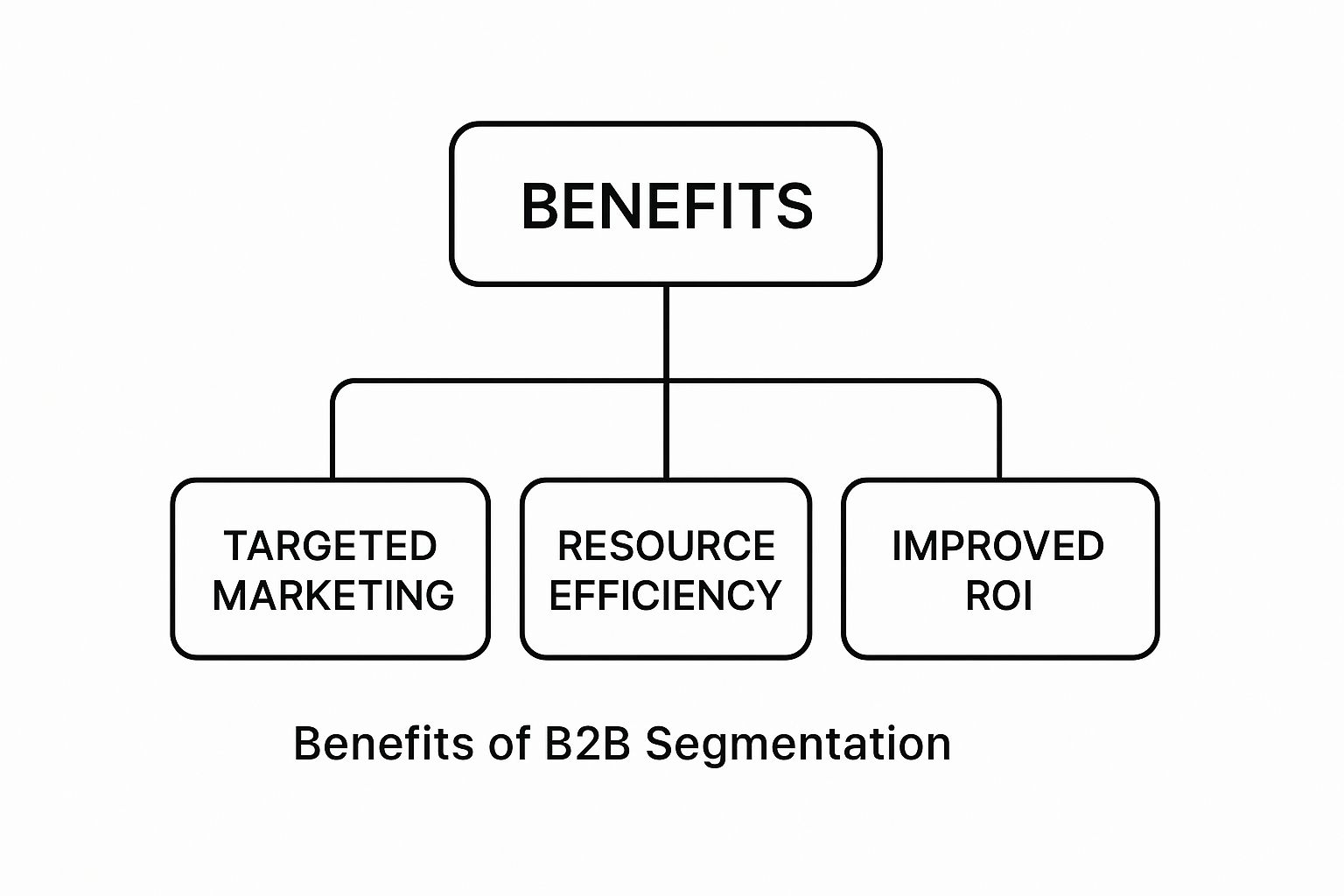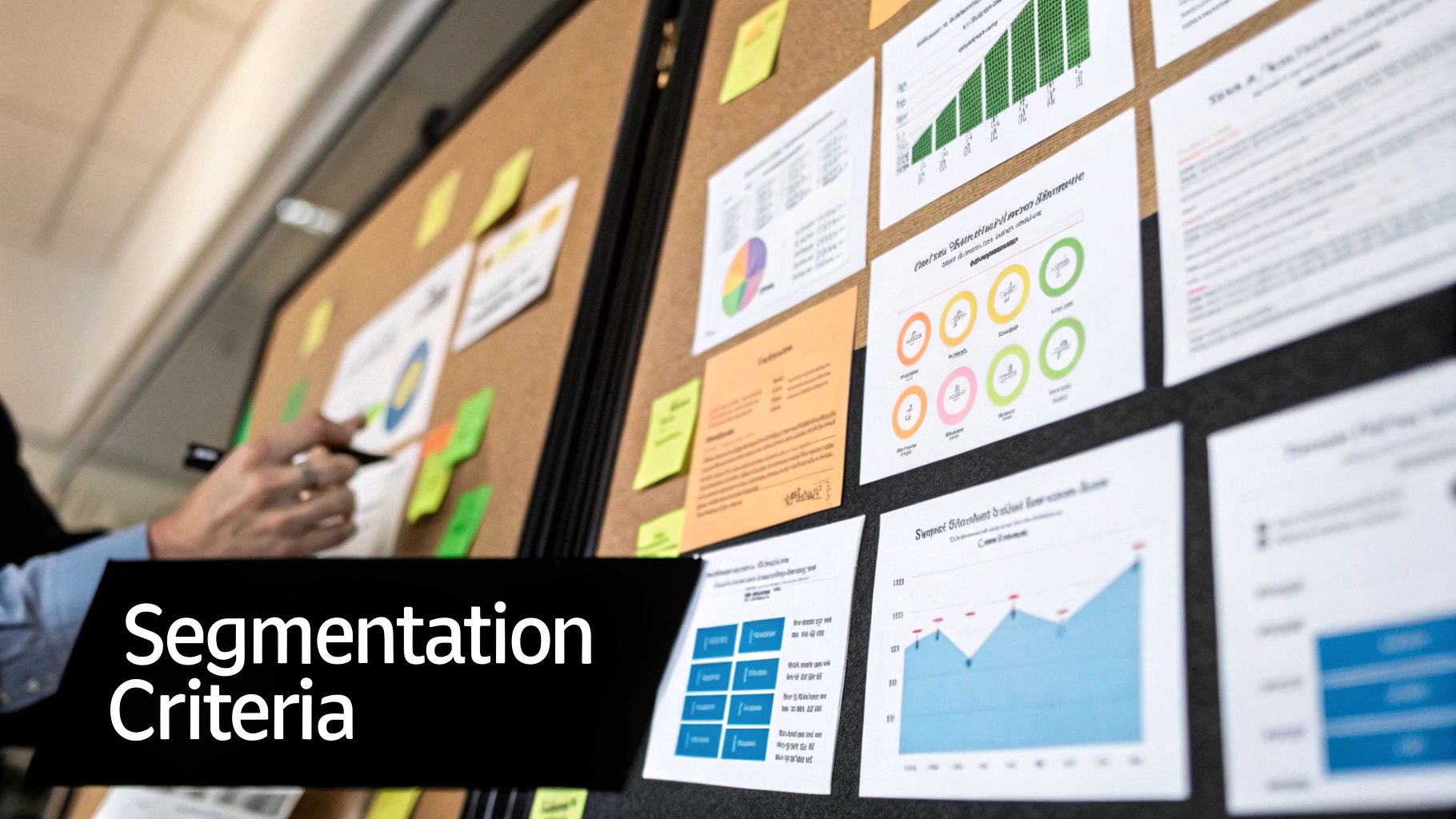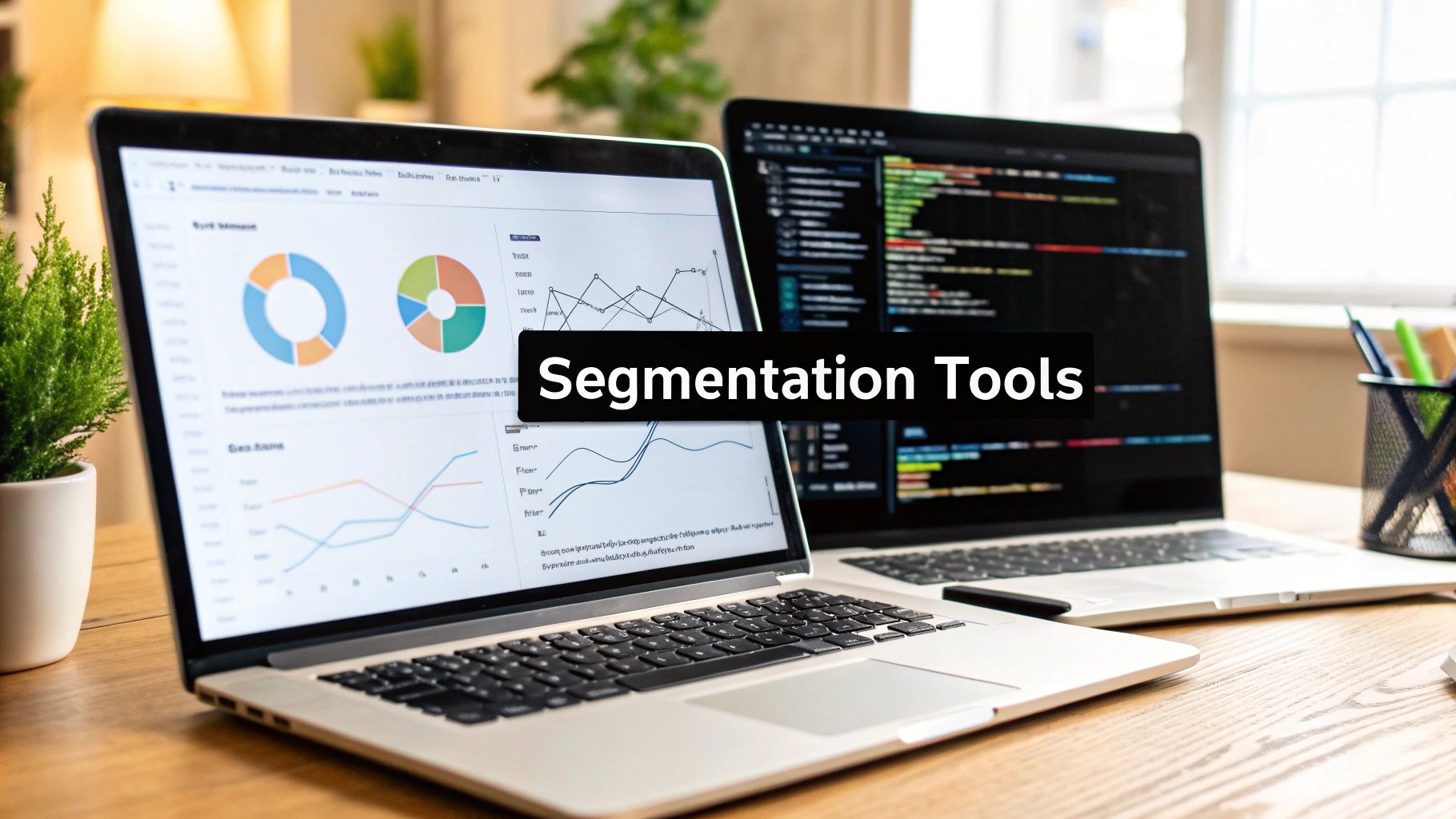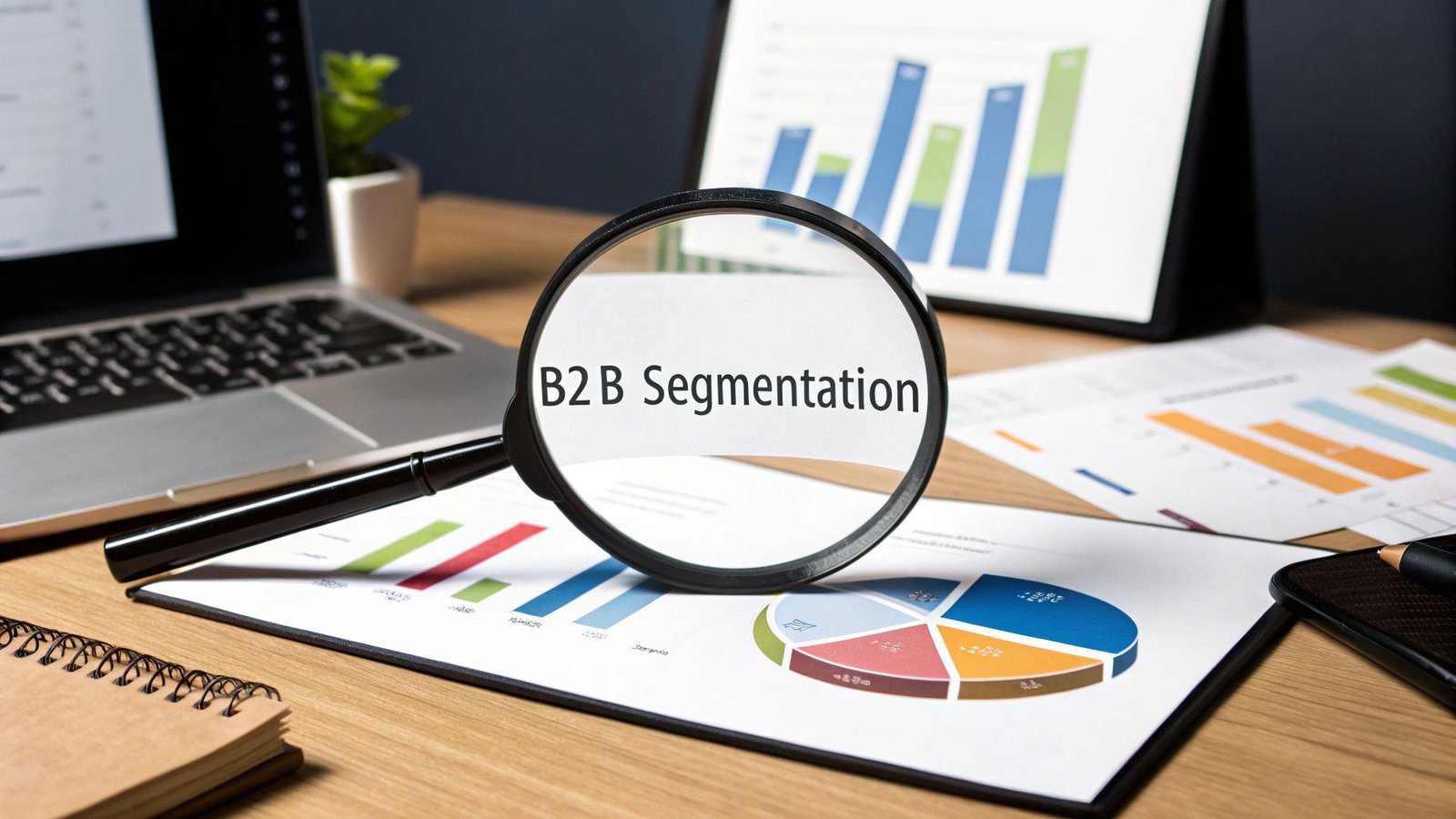At its core, business-to-business segmentation is simply the process of dividing your potential business customers into smaller, more manageable groups based on shared traits. Think of it less as a complex marketing theory and more as a practical way to stop shouting into the void and start having meaningful conversations.
This strategic approach allows you to customize your messaging, product demos, and sales outreach so they connect directly with the specific pain points and goals of each group.
Why B2B Segmentation Is a Strategic Imperative

Imagine you're in a massive, crowded stadium, trying to sell your product by yelling one generic message through a megaphone. A few people might perk up, but most will just hear noise and tune you out completely. That's exactly what sales and marketing feel like without proper segmentation—it’s inefficient, expensive, and the results are often disappointing.
Now, what if you could walk right up to small groups of people in that stadium who you know are actively looking for what you sell? You could have a real conversation. That’s the power of business-to-business segmentation. It’s not just another marketing tactic; it's a fundamental business strategy that shifts your entire approach from broadcasting to genuine connection.
From Wasted Efforts to Focused Growth
The biggest problem that segmentation solves is the incredible waste of resources—your team's time, your budget, and your energy—on prospects who were never going to buy from you in the first place. By zeroing in on your Ideal Customer Profile (ICP), you can channel all that effort where it will actually make a difference.
This laser-focused approach delivers tangible results:
- Higher Conversion Rates: Your message resonates because it’s speaking to companies with a real, urgent need for your solution.
- Improved ROI: Marketing and sales dollars are invested in high-potential accounts, not dead-end leads.
- Stronger Customer Relationships: You earn trust and loyalty by showing you truly understand the unique challenges each segment faces.
This isn't just a "nice-to-have" anymore, especially with the changing face of the B2B buyer. As of 2024, a staggering 64% of B2B buyers are Millennials or Gen Z, many of whom are under 35. This generation grew up online. They conduct an average of 12 online searches before making a purchase and expect highly personalized, digital-first interactions. You can dig deeper into these evolving B2B buyer trends to see what it means for your strategy.
In a noisy market, segmentation is your best filter. It cuts through the static to reveal high-value opportunities, letting you invest your resources with surgical precision for maximum impact and sustainable growth.
The Four Core B2B Segmentation Models
To really nail your market segmentation, you need a solid framework. Think of business to business segmentation like building a detailed profile of your ideal customer—not unlike a detective piecing together clues to solve a case. A single clue won't cut it; you need multiple data points to form a complete picture.
These clues generally fall into four foundational models. By layering these models on top of one another, you can get past surface-level assumptions and develop a rich, multi-dimensional view of the companies that genuinely need what you're selling. Each model answers a different, critical question about your potential customers.
H3: Firmographics: Who Are They?
Firmographics are the basic vitals of a business. They’re the most fundamental, yet absolutely essential, layer of your segmentation strategy. This model answers the simple question: "What are the core attributes of this company?" It's like looking at a business's ID card, giving you a quick snapshot of its size, scope, and place in the market.
Common firmographic data points include:
- Industry: Are they in fintech, manufacturing, or healthcare? This tells you a lot about their specific regulatory headaches and operational needs.
- Company Size: How many employees are on the payroll? A startup with 10 people has a completely different set of problems than an enterprise with 10,000.
- Annual Revenue: This gives you a good idea of their purchasing power and what they can realistically budget for new solutions.
- Geographic Location: Where are their headquarters and primary markets? This can influence everything from legal compliance to cultural fit.
H3: Technographics: What Tools Do They Use?
Once you know who they are, the next logical step is to understand how they work. Technographic segmentation zeroes in on a company's existing technology stack. For SaaS companies, this is gold. It reveals compatibility, integration opportunities, and potential pain points with their current setup.
For instance, finding out a prospect uses Salesforce tells you they already invest in CRM and are likely open to tools that plug into their ecosystem. This data lets you frame your pitch around seamless integration rather than asking them to rip and replace their whole system. It helps you find companies that are already "tech-ready" for your product.
H3: Behavioral Data: How Do They Act?
Behavioral segmentation goes beyond static company info to analyze how a business actually interacts with your brand and the market. It answers the question, "What actions are they taking that signal interest or need?" This is where you uncover active buying signals.
These behaviors might include:
- Visiting specific pages on your website, like your pricing or features page.
- Downloading a whitepaper or case study about a particular problem you solve.
- Engaging with your content on social media platforms like LinkedIn.
- Their historical purchase patterns or how often they’ve interacted with your sales team.
This is where the magic starts to happen. By tracking these actions, you can see which companies are just browsing and which are actively looking for a solution.

H3: Needs-Based: What Problems Do They Have?
Finally, we get to what is arguably the most powerful model: needs-based segmentation. This approach gets to the very heart of why a customer would buy from you. It groups companies based on the specific challenges they're desperate to solve or the goals they're trying to hit.
A business isn't just buying software; it's buying a solution to a frustrating problem. Understanding that core need is the key to creating a message that truly connects.
For example, one segment might need a solution to slash operational costs, while another is laser-focused on accelerating their entry into a new market. They might have identical firmographics, but their motivations are worlds apart. This model ensures your value proposition speaks directly to their most pressing pain points, making your offer infinitely more compelling.
To bring it all together, here’s a quick-reference table that summarizes these core models.
Key B2B Segmentation Models at a Glance
| Segmentation Model | Core Question It Answers | Example Data Points |
|---|---|---|
| Firmographic | Who is this company? | Industry, company size, annual revenue, location |
| Technographic | What technology do they use? | CRM software (e.g., Salesforce), marketing automation tools, cloud providers |
| Behavioral | How do they engage with us? | Website visits, content downloads, email open rates, purchase history |
| Needs-Based | What problem are they trying to solve? | Cost reduction, revenue growth, compliance, market expansion |
Each of these models provides a different lens through which to view your market. The real power comes not from using one in isolation, but from combining them to create a truly holistic and actionable picture of your ideal customer.
Putting Your Segmentation Strategy Into Action

Alright, let's move from theory to reality. This is where the magic of business to business segmentation really happens—turning your research and models into a real-world list of companies you can actually talk to. It’s all about creating a bridge between the "who" you want to target and the "how" your sales team will reach them.
Let’s walk through this with a practical example. Imagine your company just launched a slick new project management tool. You’ve noticed your best customers so far are pretty tech-savvy and work in fast-moving industries. That’s a good start, but it's too vague to be actionable.
The goal now is to sharpen that fuzzy idea into a precise targeting blueprint. This is how you set the stage for sales and marketing efforts that actually hit the mark.
Step 1: Define Your Ideal Customer Profile
First things first, you need to build a detailed Ideal Customer Profile (ICP). Think of this as layering different segmentation models on top of each other to get a crystal-clear picture of your perfect customer. It’s not just a general description; it's a specific, data-backed definition.
Let’s go back to our SaaS company. They decide to combine firmographic and technographic data to get the precision they need.
They start with the basics—the firmographics—to narrow down the field:
- Industry: Fintech. These companies live and breathe technology and need to manage projects quickly.
- Company Size: 100-500 employees. They're big enough to need a serious tool but not so massive that the buying process takes years.
- Location: United Kingdom. This helps focus their initial marketing budget and efforts.
Now for the secret sauce: the technographic layer. They know their tool integrates beautifully with Salesforce. Targeting companies that already use it means a much shorter sales cycle and fewer headaches during onboarding.
By combining these filters, the company creates an incredibly specific ICP: "UK-based fintech companies with 100-500 employees that are currently using Salesforce."
This is what separates truly effective segmentation from just casting a wide net. You now have an exact set of parameters to work with, which leads us directly to the next step.
Step 2: Build Your Prospect List with a Lead Database
With a sharp ICP in hand, the next job is to find the companies that actually fit this description. Trying to do this manually is a surefire way to waste weeks sifting through LinkedIn and company websites. This is exactly why a specialized B2B lead database, like the Nordic Lead Database, is so valuable.
These platforms let you slice and dice a massive pool of company data using the exact parameters of your ICP.

This screenshot gives you a glimpse of how it works. You can apply your firmographic filters (like industry and employee count) right alongside technographic data (like the software they use) to build a hyper-targeted list in minutes. The platform spits out a list of every company that fits your profile, often including contact info for key decision-makers.
Of course, the quality of this data is everything. Bad or outdated information can sink your entire strategy before it even starts. It's always worth understanding the common data quality problems and how to spot them.
The list you get from this process isn't just a random collection of names. It’s a highly qualified segment of the market, perfectly primed for a personalized message. Every company on that list has a high probability of needing what you sell, making your sales team’s job infinitely more efficient and, ultimately, more successful.
The Future Is AI-Powered Micro-Segmentation
Traditional B2B segmentation gave us a solid starting point, but the next evolution is already transforming how we see the market. It’s about going deeper, getting more dynamic, and letting intelligent data analysis lead the way. Welcome to AI-powered micro-segmentation—a method that leaves broad, static categories like industry or company size in the dust.
Think of it this way: old-school segmentation is like a static photograph of your market. AI-powered segmentation, on the other hand, is a live, predictive video feed. It can analyze millions of real-time data points all at once, picking up on signals like website engagement, content downloads, and purchase intent. This helps uncover niche buying groups that would otherwise be completely invisible. We're not just grouping similar companies anymore; we're pinpointing clusters of businesses that are showing active buying behavior right now.
From Broad Categories to Dynamic Clusters
Static segmentation might tell you to target "fintech companies with 500 employees." That's a decent start, but it's incredibly broad.
AI-powered micro-segmentation identifies a far more valuable group, like: "fintech companies that recently visited your pricing page, downloaded a case study on API integration, and whose decision-makers are actively researching your competitors online."
That level of detail is a complete game-changer. Here’s why:
- Hyper-Personalization at Scale: AI lets you craft messages that speak directly to a company's immediate needs and recent activities, making your outreach feel incredibly relevant.
- Efficient Ad Spend: You can stop wasting your budget on companies that just happen to fit a demographic profile. Instead, you focus only on those showing clear signs they're ready to buy.
- Predictive Insights: These systems can even forecast which segments are most likely to convert next. This allows you to get in front of them before your competition even knows they exist.
This shift is happening fast. In 2025, B2B marketers are rapidly moving away from traditional methods and embracing AI-driven segmentation. This change is powered by massive customer datasets and advanced analytics that create segments based on real-time intent signals. As a result, over a third of B2B marketers already using AI for segmentation report significant jumps in engagement rates. You can find more insights on how AI is shaping B2B marketing strategies.
Uncovering Hidden Opportunities
The real magic of AI in B2B segmentation is its ability to connect dots a human analyst could never see on their own. It might reveal that your best customers aren't defined by their industry, but by the specific combination of software they use or the business challenges they're researching online.
AI doesn’t just refine your existing segments; it reveals entirely new, high-value micro-segments based on behavior and intent, giving you a powerful competitive edge.
To really make these advanced insights work, your foundational data has to be clean, accurate, and constantly updated. This is where a process like B2B data enrichment becomes non-negotiable. It ensures your AI models are fueled by the highest quality information.
By pairing powerful AI tools with a rock-solid data foundation, you can finally move from reactive marketing to predictive, personalized outreach that truly drives growth.
Using Segmentation to Fuel Account-Based Marketing

Think of smart business to business segmentation as the secret sauce for a powerful Account-Based Marketing (ABM) program. It's not just a box you tick before you start; it's the very engine that makes ABM work.
ABM is all about precision. Instead of spraying your message everywhere and hoping something sticks, you focus your energy on a handpicked list of high-value accounts. Segmentation is how you build that list, giving you the intelligence to know exactly which targets are worth the effort.
This connection is where the magic happens. With sharp segmentation, you can pinpoint the companies that are a perfect match for what you offer. You stop sending generic emails and start treating your top prospects like partners, building campaigns that speak directly to their unique challenges.
Building Your ABM Tiers
A popular and highly effective way to structure this is by creating tiers. This approach helps you spend your time and budget where they’ll make the biggest impact.
-
Tier 1: These are your "white whale" accounts. It’s a very small list of high-revenue, strategically crucial companies that get the full white-glove treatment with one-to-one, hyper-personalized marketing.
-
Tier 2: This group includes accounts that look a lot like your Tier 1 targets. For them, you can use a "one-to-few" strategy, creating customized campaigns for small, similar clusters of businesses.
-
Tier 3: This is your broadest segment, often defined by firmographic or technographic data. Here, a "one-to-many" approach works well, using technology to send lightly personalized messages at a larger scale.
This tiered system ensures your most resource-intensive work is reserved for the accounts with the highest potential payout. Every single tier, however, is built on a foundation of solid, data-backed segmentation.
Driving Real Business Outcomes
The real beauty of pairing segmentation with ABM is the results you can actually see. When sales and marketing are completely in sync about who to target and why, the whole revenue process just runs better.
And the numbers back this up. Recent research shows that 64% of client-centric organizations see a much higher return on investment (ROI) from their ABM efforts compared to other marketing plays. These companies also benefit from better engagement and faster deal cycles.
When you use segmentation to power your ABM program, you stop chasing every shiny object and start aiming your resources where they’ll count the most. This strategic focus is how you build better client relationships and drive real, sustainable growth.
Ultimately, this alignment creates a unified force between your sales and marketing teams. It also gives you a clear way to measure what’s working and tweak your strategy as you go. This is a core part of many modern demand generation strategies that value quality leads over a high volume of unqualified ones.
Common B2B Segmentation Questions Answered
Even with the best strategy laid out, jumping into business-to-business segmentation for the first time usually kicks up a few questions. That's completely normal. You start thinking about the details and wonder how it all works in the real world. Let's walk through some of the most common questions I hear to clear things up.
Think of this as your quick-start FAQ—straightforward answers to get you over the initial hurdles and moving forward with confidence.
What Is the Difference Between B2B and B2C Segmentation?
The biggest difference is who you're targeting and what you're looking at. B2C segmentation is all about the individual. You're using demographics like age, psychographics like their hobbies or values, and personal buying habits. You’re trying to understand one person, and decisions are often driven by emotion.
B2B segmentation, on the other hand, is about the entire company. Instead of personal traits, we rely on firmographics (things like company size or industry) and technographics (what software they already use). You aren't just selling to one person; you’re solving a complex problem for a group of stakeholders. The whole process is far more logical and data-driven.
In short: B2C sells to a person; B2B sells to a business. That one shift changes everything—from the data you need to the marketing messages that actually work.
How Many Segments Should My Business Have?
There's no magic number. The right number of segments really depends on how complex your market is and, frankly, what your team can handle. A great starting point is to aim for 3-5 well-defined segments. This keeps things manageable.
The goal is to find groups that are different enough to justify a unique approach but big enough to be worth your time and effort. Trying to manage a dozen tiny segments can dilute your focus just as much as having one generic message for everyone. It's always better to master a few segments than to do a mediocre job with many.
You can always get more granular later. Start simple, learn what works, and then expand.
What Are the First Steps to Implementing B2B Segmentation?
Getting started is less about reinventing the wheel and more about looking at what's already working. The best place to begin is with your existing customer list.
Here’s a simple three-step approach:
-
Analyze Your Best Customers: Pull a list of your most successful, profitable, and happiest clients. What do they all have in common? Look for patterns in their industry, company size, location, and even the tech they use. This is how you start building your Ideal Customer Profile (ICP).
-
Gather Broader Market Data: Once you have a rough ICP, you need to see if there are enough of these companies out there. Use market research or a good lead database to validate the size of the opportunity. This step confirms your ideal segment is actually big enough to target.
-
Launch a Pilot Campaign: Don't try to do everything at once. Pick one or two of your most promising segments and run a small, focused campaign. Craft a message specifically for them, track the results closely, and see what you learn before you go all-in.
Ready to build hyper-targeted prospect lists based on precise segmentation? The Nordic Lead Database gives you the firmographic and technographic filters you need to find your ideal customers in minutes. Discover high-quality B2B data at https://nordicleaddatabase.com.
